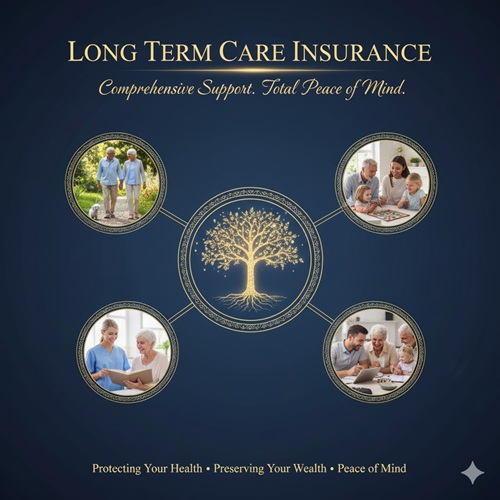
🛡️🏠 Long-Term Care Insurance: Securing Your Future: A Comprehensive Guide to Long-Term Care Insurance 👵👴
Long-Term Insurance Care: The dream of retirement often features travel, hobbies, and time with loved ones. Yet, a crucial, frequently overlooked, aspect of financial planning is the potential cost of long-term care (LTC). This type of care encompasses a range of services designed to help people live independently when they can no longer perform daily activities.1 The costs for these services—which can include nursing home stays, in-home care, and assisted living—are staggering and can quickly deplete a lifetime of savings.2
Long-Term Care Insurance is a specialized financial product designed to cover these expenses, protecting your assets and ensuring you have access to quality care without burdening your family.3 For most Americans reaching age 65, there’s an estimated 70% chance they will need some form of long-term care services in their remaining years. This makes the question of how to pay for it one of the most pressing financial decisions facing modern families.
This article delves into the world of Long-Term Care Insurance, detailing what it covers, illustrating its vital role in comprehensive retirement planning, and providing clear comparisons, scenarios, and professional guidance.
📜 Table of Contents
-
1. 🔑 Defining Long-Term Care Insurance (LTCi)
-
2. 💰 The High Cost of Long-Term Care: Why Insurance is Necessary
-
3. 🛡️ What Does Long-Term Care Insurance Cover?
-
3.1 Eligibility Triggers: Activities of Daily Living (ADLs) and Cognitive Impairment
-
3.2 Covered Settings and Services
-
3.3 The Benefit Pool, Daily Limit, and Elimination Period
-
-
4. 🎯 Who Needs Long-Term Care Insurance?
-
4.1 The Affluent: Asset Protection
-
4.2 The Middle Class: Preventing Impoverishment
-
4.3 The Healthy: Securing Lower Premiums
-
-
5. 📊 Types of Long-Term Care Insurance: Comparison Table
-
5.1 Traditional LTC Insurance
-
5.2 Hybrid (Asset-Based) LTC Insurance
-
-
6. 💡 Scenarios and Outcomes: The LTCi Difference
-
6.1 Scenario A: The Single Woman’s Financial Security
-
6.2 Scenario B: The Couple Facing Concurrent Care Needs
-
6.3 Scenario C: Protecting a Family Inheritance
-
-
7. 🔄 Long-Term Care Insurance vs. Other Funding Methods (Comparison Table)
-
8. ❓ Q&A: Addressing Common Concerns about Long-Term Care Insurance
-
9. 📞 Next Steps: Partnering with Specialized Insurers
1. 🔑 Defining Long-Term Care Insurance (LTCi)

Long-Term Care Insurance is a policy that pays a daily or monthly benefit for care when an individual cannot care for themselves due to chronic illness, disability, or cognitive impairment.4 It is distinct from health insurance, which covers acute medical issues, and it is crucial to understand its core function: to provide financial resources for custodial care, not medical treatment.5
The Financial Bridge
LTC insurance serves as a financial bridge between a catastrophic health event and the protection of your retirement nest egg.6 The keyword “Long-Term Care Insurance” highlights its function as a specialized solution to a specialized risk. Without it, the cost of care—which averages over $100,000 annually for a private nursing home room—must be paid from savings, investments, or by eventually qualifying for Medicaid, which requires exhausting most personal assets.7
2. 💰 The High Cost of Long-Term Care: Why Insurance is Necessary

The primary driver for considering Long-Term Care Insurance is the sheer, escalating cost of care services. Unlike routine medical expenses, long-term care costs are persistent and non-medical.
Average Annual Costs (2024 Estimates) 💸
| Type of Care | National Average Annual Cost | Duration of Need (Average) |
| Home Health Aide (44 hours/week) | $68,640 | 3 years |
| Assisted Living Facility (Private 1BR) | $63,000 | 2.5 years |
| Nursing Home (Private Room) | $116,800 | 1.5 years (in facility) |
If an individual requires 3 years of assisted living followed by 1.5 years in a nursing home, the total estimated cost exceeds $380,000. This figure is often borne directly by the individual and their family.
3. 🛡️ What Does Long-Term Care Insurance Cover?

The coverage provided by a Long-Term Care Insurance policy is comprehensive, but it hinges on specific eligibility criteria and policy design.
3.1 Eligibility Triggers: Activities of Daily Living (ADLs) and Cognitive Impairment
A policyholder becomes eligible (or “triggers” benefits) when a healthcare professional certifies that the individual meets one of two criteria:
-
Inability to perform a minimum number of Activities of Daily Living (ADLs): The policy typically requires the inability to perform two out of six ADLs without substantial assistance. These six ADLs are:
-
Bathing 🛁
-
Continence
-
Dressing 👕
-
Eating 🍽️
-
Toileting
-
Transferring (getting in and out of a bed or chair)
-
-
Severe Cognitive Impairment: This is defined as a deterioration or loss of intellectual capacity (e.g., Alzheimer’s disease, dementia) that requires substantial supervision for the insured’s protection or others’ protection.
3.2 Covered Settings and Services

The significant advantage of Long-Term Care Insurance is its flexibility in where care can be received, a key differentiator from Medicaid’s restrictive nature. Covered settings typically include:
-
In-Home Care (Home Health Care): Assistance from skilled nurses, home health aides, or even family members (depending on the policy) who receive compensation. This is often the preferred and least costly setting.
-
Assisted Living Facilities (ALFs): Residential settings that provide meals, supervision, and some level of medical and personal care.8
Nursing Homes (Skilled Nursing Facilities): Provide 24-hour skilled nursing care and rehabilitation services.9
Hospice Care and Respite Care: Coverage for services provided to the terminally ill, as well as temporary care for a loved one to provide a break for the primary family caregiver. -
Adult Day Care Centers: Structured daytime programs that provide social and health services in a community setting.
3.3 The Benefit Pool, Daily Limit, and Elimination Period

Three core variables determine how a Long-Term Care Insurance policy pays out:
| Policy Variable | Description | Planning Impact |
| Daily/Monthly Limit | The maximum dollar amount the policy will pay per day (e.g., $200) or per month (e.g., $6,000) for care. | Determines the quality of care you can afford (e.g., private room vs. semi-private). |
| Benefit Pool (Maximum Lifetime Benefit) | The total dollar amount available over the life of the policy. It’s often the daily limit multiplied by the policy’s benefit duration (e.g., 3, 5, or 10 years). | Dictates the maximum time the policy will pay benefits before the funds are exhausted. |
| Elimination Period (Deductible) | The number of days (e.g., 30, 60, 90, 100) the insured must pay for care out-of-pocket after benefits are triggered, before the policy starts paying. | A more extended period reduces the premium but increases the immediate out-of-pocket expense. |
4. 🎯 Who Needs Long-Term Care Insurance?

While the need for care is high for everyone, the decision to purchase Long-Term Care Insurance often comes down to protecting assets and ensuring control over care options.
4.1 The Affluent: Asset Protection
Individuals with high net worth (typically $3 million or more in liquid assets) might initially believe they can self-insure. However, long-term care costs can still be substantial, especially for couples requiring concurrent care. For the affluent, Long-Term Care Insurance is a tool for wealth preservation and tax-advantaged funding. Premiums may be tax-deductible for some individuals, and the benefits paid out are generally tax-free.
4.2 The Middle Class: Preventing Impoverishment

The middle class (those with assets between $250,000 and $3 million, excluding the primary residence) is the most vulnerable. They have too many assets to qualify for immediate government assistance (Medicaid) and not enough assets to comfortably self-insure a multi-year care need. For this group, Long-Term Care Insurance is a necessity to prevent a single health crisis from wiping out their retirement savings and potentially requiring them to spend down their wealth to poverty levels to qualify for Medicaid.
4.3 The Healthy: Securing Lower Premiums
Health status is a significant underwriting factor.10 The best time to secure Long-Term Care Insurance is typically in your 50s or early 60s, when premiums are lower and you are most likely to qualify for the best health class (which offers the lowest rates).11 Waiting until health issues arise (diabetes, heart conditions) can lead to higher premiums or outright denial of coverage, making the decision more urgent for those currently in good health.
5. 📊 Types of Long-Term Care Insurance: Comparison Table

The LTC insurance market has evolved beyond the traditional model. Today, buyers primarily choose between two main types of Long-Term Care Insurance: Traditional (Stand-Alone) and Hybrid (Asset-Based). .12
| Feature | Traditional LTC Insurance | Hybrid (Asset-Based) LTC Insurance |
| Policy Structure | Stand-alone insurance policy. | Life Insurance or Annuity with an LTC rider. |
| Premium Structure | Level premium initially, but premiums can increase over time (not guaranteed). | Premiums are typically guaranteed and fixed; usually paid in a single lump sum or 10-year period. |
| Guaranteed Value | “Use it or Lose it.” If you never need care, no benefits are paid to your heirs. | Guaranteed payout. If LTC benefits are not used, the policy pays a death benefit to heirs or a return of premium upon cancellation. |
| Underwriting | Detailed medical underwriting (physical exam, medical records review). | Often simplified underwriting; easier to qualify. |
| Target Buyer | Those prioritizing a high, flexible benefit pool for a lower initial premium. | Those concerned about premium hikes and the “use it or lose it” risk desire guaranteed values. |
5.1 Traditional LTC Insurance

Traditional policies focus solely on covering long-term care services.13 They offer the most robust and customizable coverage for the lowest initial cost. The risk is that premiums are not guaranteed and could increase years later —a significant concern for many buyers of Long-Term Care Insurance.
5.2 Hybrid (Asset-Based) LTC Insurance
These policies combine life insurance or an annuity with a long-term care benefit rider.14 A single, significant premium payment funds the policy. The primary benefit is the guarantee: you either receive money for care, or your heirs receive a death benefit. This eliminates the “use it or lose it” risk, making it a very popular choice for funding Long-Term Care Insurance today.
6. 💡 Scenarios and Outcomes: The LTCi Difference

These scenarios demonstrate the profound financial impact of having a Long-Term Care Insurance policy versus relying solely on personal savings.
6.1 Scenario A: The Single Woman’s Financial Security
-
The Individual: Sarah, a single, retired woman with $1 million in savings. She needs 4 years of assisted living and home care, costing an average of $75,000 per year (Total cost: $300,000).
-
No LTCi Outcome: Sarah depletes 30% of her entire savings ($300,000), significantly reducing the income-producing assets needed for her remaining retirement and jeopardizing her ability to maintain her standard of living.
-
LTCi Outcome: Sarah’s Long-Term Care Insurance policy pays the full $300,000 benefit. Her $1 million retirement portfolio remains fully intact, ensuring her financial independence and ability to leave an inheritance. LTC insurance protected her capital.
6.2 Scenario B: The Couple Facing Concurrent Care Needs
-
The Couple: John and Mary, married with $1.5 million in shared assets. Both require long-term care services: John needs 3 years of nursing home care ($350,000 total), and Mary needs 2 years of home care ($140,000 total)—total combined cost: $490,000.
-
No LTCi Outcome: The $490,000 cost consumes nearly a third of their entire marital wealth. The remaining spouse (if one survives the other) is left with greatly diminished assets, potentially struggling to afford their own subsequent care needs.
-
LTCi Outcome: They utilized a Joint Policy for their Long-Term Care Insurance, providing a shared $500,000 benefit pool. The policy covers nearly all of their combined care costs. The remaining $1.5 million portfolio is preserved, securing the financial stability of the surviving spouse.
6.3 Scenario C: Protecting a Family Inheritance

-
The Asset: Mr. Chen owns a primary home and wishes to leave $500,000 in liquid assets to his grandchildren. He requires 5 years of nursing home care, costing $580,000.
-
No LTCi Outcome: Mr. Chen must spend down his $500,000 in savings and may place a lien on his home to cover the costs until he qualifies for Medicaid. The intended inheritance is wholly lost.
-
LTCi Outcome: Mr. Chen purchased a Hybrid Long-Term Care Insurance policy that guaranteed a minimum benefit of $500,000. The policy pays for the majority of his care. Upon his passing, the policy’s residual death benefit (or a small portion of the original $500,000 savings) is passed to the grandchildren, and the home remains unencumbered. Long-Term Care Insurance protected the legacy.15
7. 🔄 Long-Term Care Insurance vs. Other Funding Methods (Comparison Table)

It’s vital to understand why Long-Term Care Insurance is often the superior financial tool compared to other standard methods of funding long-term care.
| Funding Method | Key Benefit | Key Drawback (Risk) | Coverage Focus |
| Personal Savings/Investments | Complete control over the funds. | High risk of depleting capital; no leveraging (dollar-for-dollar spend). | Any care, until funds are exhausted. |
| Medicare | No cost to the user. | Highly restrictive; only covers short-term, skilled care (up to 100 days); does not cover custodial care. | Acute medical needs and short-term rehab. |
| Medicaid | Government-funded. | Requires poverty (asset spend-down); limited choice of facilities; generally only covers nursing home care. | Last resort for the financially impoverished. |
| Long-Term Care Insurance (LTCi) | Leveraged protection (benefits far exceed premiums); protects assets; provides choice in care setting. | Requires timely payment of premiums; premiums may increase (Traditional); requires medical qualification. | Custodial care in the home, assisted living, or a nursing home. |
8. ❓ Q&A: Addressing Common Concerns about Long-Term Care Insurance

Q: What is the ideal age to purchase Long-Term Care Insurance?
A: The sweet spot is generally between 55 and 65.16. Purchasing too early (in your 30s or 40s) means paying premiums for decades before the risk is highest. Waiting too long (mid-to-late 60s or 70s) means premiums are significantly higher, and the risk of being uninsurable due to health issues increases dramatically.17 The younger and healthier you are when you apply, the lower your premium will be for the life of the policy.
Q: Are the premiums for Long-Term Care Insurance tax-deductible?
A: Yes, premiums for Long-Term Care Insurance can be tax-deductible, but they are subject to limitations based on your age and the specific IRS tax code rules for medical expenses.18 The younger you are, the smaller the allowable deduction. However, the benefits you receive from a qualified policy are generally not taxable as income.
Q: How does inflation factor into Long-Term Care Insurance?
A: Inflation is crucial because the cost of care services can rise by 3% to 5% annually. Most modern Long-Term Care Insurance policies offer an inflation rider. The most common options are:
-
3% or 5% Compound Inflation: The benefit pool grows by this percentage compounded annually, ensuring that the total benefit pool keeps pace with rising care costs over 20-30 years. This rider is highly recommended as it future-proofs the policy.
Q: Why not just rely on a Personal Umbrella Liability Policy?
A: A Personal Umbrella policy only covers liability (claims against you for damage or injury to others). It does not cover expenses for your own long-term care needs (custodial care, assisted living, nursing home fees). Long-Term Care Insurance is specifically designed to cover those care costs.
Q: What happens if I move to another state?
A: Long-Term Care Insurance is generally portable across state lines.19 The policy pays benefits regardless of which state (or sometimes country, for short periods) the care is received in, provided the facility or care provider is appropriately licensed.
9. 📞 Next Steps: Partnering with Specialized Insurers

Selecting the right Long-Term Care Insurance policy—whether Traditional or Hybrid—is a complex decision that requires professional guidance to balance the daily benefit properly, the total benefit pool, and the inflation rider against your budget and risk profile. This planning is best done with an advisor who specializes in comprehensive retirement and long-term care planning.
For a detailed, personalized consultation on your Long-Term Care options and to determine the proper policy structure for your family’s unique financial situation, you can contact a specialized financial and insurance partner.
Sun Insurance and Financial
Telephone: (310) 860-5000
Conclusion: The Ultimate Retirement Protector 🌟
Long-Term Care Insurance is more than just an insurance policy; it is a critical component of a responsible retirement plan.20 It represents a promise to yourself and your family: that you will not deplete your life savings on care costs and that your children will serve as caregivers by choice, not by financial necessity. By transferring the financial risk of long-term care, you secure not only your own dignity and quality of life in later years but also the financial future and peace of mind of those you love most. Investing in Long-Term Care Insurance is truly investing in a secure and dignified future.
Traditional vs. Hybrid LTC Insurance: A Comparative Analysis
Hypothetical Scenario: The Middle-Class Couple
-
Couple Profile: Healthy married couple, both aged 55, residing in a middle-cost-of-care area.
-
Asset Status: $500,000 in retirement savings/investments (excluding primary home equity). This is their asset target for retirement income.
-
Goal: Secure a shared benefit pool that will cover approximately 4 years of care for one person, starting 30 years from now, with protection against inflation.
-
Target Coverage: A policy providing an initial combined Monthly Benefit of $6,000 (or $3,000 per person) with 3% Compound Inflation protection.
Comparison of Financial Outcomes

The goal is to protect the $500,000 asset base from being consumed by a care event.
| Policy Feature | Traditional LTC Insurance (Annual Pay) | Hybrid LTC Policy (Single Pay) |
| Initial Premium (Combined, Age 55) | $3,800 – $5,000 per year (Estimated) | $120,000 – $150,000 (Single lump sum) |
| Premium Structure | Ongoing (Pay to age 90, or for life). Not guaranteed. | Guaranteed fixed premium (Paid in one lump sum or 10 annual payments). |
| Total Outlay (If paid for 30 years) | $114,000–$150,000 (before any premium increases) | $120,000–$150,000 (Fixed and guaranteed) |
| Care Benefit Leverage | High: ~$150K in premiums can secure a benefit pool nearing $1.5M (due to compounding). | Lower: ~$150K premium might secure initial LTC benefits (3x-5x leverage). |
| Inflation Protection | Highly customizable (3%, 5%, Simple or Compound) | Often limited to a fixed 3% Compound or simple rate. |
| “Use It or Lose It” | Yes. If no claim is made, the $114K+ in paid premiums is gone. | No. If no claim is made, the full $150,000 (or more) amount is paid as a death benefit. |
| Underwriting | Strict. Requires extensive medical review. | Often Simplified. Easier to qualify for those with moderate health issues. |
| Tax Treatment | Premiums may be tax-deductible (subject to age limits). Benefits are tax-free. | Premiums are not deductible. Benefits are tax-free. |
The Decision Factors for This Couple 🧐
1. The Traditional LTC Path (Risk vs. Reward)
-
✅ Pro (Maximal Leverage): For an annual payment of around $4,000, the couple receives the highest possible future LTC benefit. This is the most cost-effective way to purchase a large future benefit pool.
-
❌ Con (The Risk of Rate Hikes): The significant risk is that the premium is not guaranteed. Insurance companies have sought and received substantial rate increases on many older Traditional policies. If their $4,000 premium jumped to $10,000 at age 75, it could become unaffordable, forcing them to drop the policy and lose all prior premiums.
-
Best Fit: The couple is comfortable with annual payments and is prioritizing the most significant possible future LTC benefit while accepting the risk of future premium increases.
2. The Hybrid LTC Path (Certainty vs. Opportunity Cost)
-
✅ Pro (Guaranteed and No Loss): The premium is guaranteed never to increase. Furthermore, if they never need care, their children are guaranteed to receive a death benefit, eliminating the “use it or lose it” risk. This offers the ultimate peace of mind and asset protection.
-
❌ Con (Upfront Cost & Opportunity Cost): It requires liquidating their $500,000 asset base today. This capital is now locked into the policy, and they lose the potential for higher market returns that the $150,000 could have generated over 30 years.
-
Best Fit: The couple is prioritizing certainty in their retirement budget, absolutely needs the guarantee that their premiums won’t change, and values the death benefit guarantee as a trade-off for the reduced market exposure. This is often the preferred choice for those who are moving money (e.g., from a low-yield CD) rather than spending new money.
Strategic Recommendation for the Middle-Class Couple 🎯

For a middle-class couple whose $500,000 asset base is crucial for income, the need for premium stability is paramount. A significant rate hike on a Traditional policy could force them to drop coverage at the exact time they are approaching the highest risk age (70s/80s).
The Hybrid LTC Policy is often the more secure recommendation for this asset level because it:
-
Guarantees Premiums: Ensures that the LTC coverage remains affordable throughout retirement, making the budget predictable.
-
Protects Principal: Guarantees that the investment is never “lost” and will pass to heirs if LTC is not needed, making it a defensive financial move rather than a pure expense.
-
Simplifies Planning: By paying a single lump sum (or 10 fixed annual payments), they eliminate a yearly recurring expense from their variable retirement budget.
This approach successfully carves out and leverages a portion of their $500,000 to protect the entire remaining asset base from the catastrophic risk of long-term care costs.
To determine which Long-Term Care Insurance product best aligns with your health status, budget, and estate planning goals, it is essential to consult a specialist.
Sun Insurance and Financial Telephone: (310) 860-5000
Sun Insurance and Financial https://SunInsurance.us
Travelers Insurance
The Hartford Insurance
California Fair Plan Insurance
Hiscox Insurance
